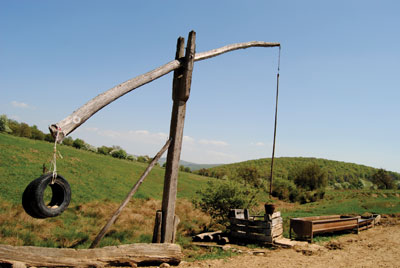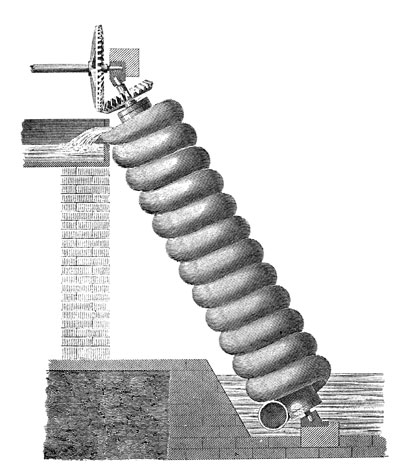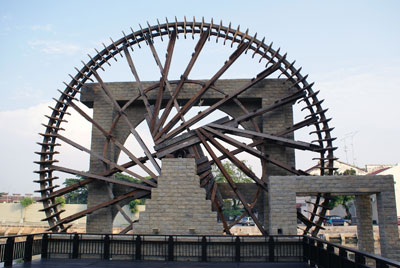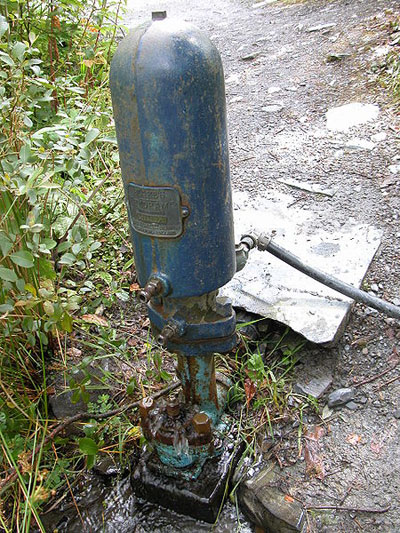
Products
Products
Back to the beginning
A glimpse into the history of pumps.
July 5, 2012 By Stefanie Wallace
Pumps are essential to your business, but do you know where they come from? Ground Water Canada did some digging to bring you a brief history of some of the most popular pumps.
Pumps are essential to your business, but do you know where they come from? Ground Water Canada did some digging to bring you a brief history of some of the most popular pumps.
 |
|
| A shaduf, the first water pump dating back to between 3000 and 2000 BC. Advertisement
|
Ancient water pumps
Shaduf – The first water pump dates back to between 3000 and 2000 BC, originating in the Mesopotamia area of southwestern Asia in present-day Iraq, northeastern Syria, southeastern Turkey and southwestern Iran (the name Mesopotamia means “land between rivers”). Called the shaduf, or shadoof, the pump consisted of a wooden lever beside the riverbank, pivoted on two vertical posts. A pole was attached to a bucket and suspended from one of the levers, with a counterweight fixed to the other end. The user of the pump pushed the pole down, filling the bucket with water, and the weight raised the bucket. The system is used to move water from one body of water to another. The shaduf was popular throughout the Middle East, and has been said to be the only form of water pump used in the region for the next 2,000 years. The shaduf is still used in India and Egypt to irrigate land.
Noria – Dating back to 700-600 BC, the noria, or the Egyptian water wheel, consisted of buckets or clay pots along the circumference of a wheel that was powered by the water current. As the buckets were immersed and filled with water, gravity forced the buckets at the top of the wheel to empty into a trough, and the wheel continued in a circular motion. According to the Irrigation Museum, the noria was the first non-human-operated lifting device.
Sakia – Also called the Persian water wheel, or the tympanum, the sakia is similar to the noria, except an external force powered the wheel, rather than the river current. A sakia consists of buckets attached to an upright wheel. Traditionally, animals such as horses or oxen powered sakias. Sakias are still used in Egypt and are now made from galvanized sheet steel, although they are now powered mechanically.
 |
|
| The Archimedes’ screw.
|
Archimedes’ screw – In about 250 BC, Archimedes, a Greek mathematician and inventor, devised a pump made of a metal pipe in a corkscrew that revolved, drawing water up the tube until it eventually poured out the top. The screw was usually turned by hand or by a windmill. The Archimedes’ screw was typically used for draining water from mines or areas of shallow water. Although the screw pump is credited to Archimedes, historians believe he merely popularized a device he saw while visiting Egypt. British engineer John Burland used an Archimedes’ screw in 2001 to stabilize the Leaning Tower of Pisa. Archimedes’ screws are also used in sewage treatment plants. Snowblowers and grain elevators are equipped with augers, which are essentially the same as Archimedes’ screws. The Archimedes’ screw will rotate when water is poured on top of it, allowing the rotating screw to be used to drive an electric generator.
In 1830, Revillion invented the modern screw pump, which consisted of a right- and a left-handed screw meshing together, being driven in opposite directions.
Water organ – The water organ is the predecessor of the modern force pump. Designed by Ctesibus of Alexandria, Egypt, around 200 BC, the water organ is an air pump with valves on the bottom, and a cylinder with a plunger at the top, which creates a vacuum, drawing water upward through the valves. This pump was usually made of bronze and valves and plungers were also incorporated into other kinds of machinery, such as military equipment.
Positive displacement pump
Around 1650, Otto von Guericke, a German scientist, invented the piston vacuum pump, using leather washers to prevent leaks between the cylinder and the piston.
Aldrich Pump Company began manufacturing the world’s first line of reciprocating positive displacement pumps for steel mills and mine dewatering in 1902.
Sir Samuel Morland, an English academic, invented the plunger pump in 1675 in an attempt to improve the water supply to Windsor Castle.
Charles C. Barnes of Sackville, N.B., patented the rotary vane pump on June 16, 1874.
Centrifugal pump
Reti, a Brazilian soldier and historian of science, claims the centrifugal pump was a mud-lifting machine developed by Francesco di Giorgio Martini, an Italian Renaissance engineer. In 1687 French inventor Denis Papin developed the first true centrifugal pump with straight vanes, which was used in local drainage work. John Appold, a British inventor, introduced the curved vane in 1851.
 |
|
| The Noria, an Egyptian water wheel dating back to 700 to 600 BC.
|
John Gwynne filed for his first centrifugal pump patent in 1851. His early pumps were used primarily for land drainage, and many can still be seen today in pump house museums. Gwynne’s steam engines usually powered the pumps. When John died in 1855, James Gwynne took over the company, and other family members formed a rival company. The two firms reunited in 1903 as Gwynnes Ltd. By the end of the 19th century, Gwynnes was producing pumps of all sizes to cover all industrial applications, from small electric pumps to those rated at 1,000 tons per minute.
The multistage centrifugal pump was developed in 1905, but Ground Water Canada was unable to locate information about its developer.
 |
|
| A hydraulic ram at the Center for Alternative Technology.
|
Hydraulic ram pumps
John Whitehurst, from the United Kingdom, invented the precursor to the hydraulic ram pump in 1772. The manually controlled device raised water to a height of 4.9 metres (16 feet). Joseph Michel Montgolfier (the French co-inventor of the hot air balloon) invented the first automatic ram pump in 1796. Montgolfier’s sons obtained an Engliish patent for an improved version of the pump in 1816. Josiah Easton, an English engineer, acquired Whitehurst’s design and the Montgolfier patent in 1820.
The first American patent was issued to J. Cerneau and S.S. Hallet in 1809, sparking more interest in hydraulic rams in the United States.
Submersible pumps
Armais Sergeevich Arutunoff invented submersible pumps in Russia in 1916, but they were not used in the United States until the 1950s. His pump was originally designed for use in ships, water wells and mines, but he later altered the design to be used in oil wells. Further refinements to Arutunoff’s original design allowed for other applications, such as pumping drinking water and wastewater, and creating fountains.
Variable speed/constant pressure pumps
Variable speed pumps, used to make a constant pressure system, initially came from the European market. Larger applications have been applying variable frequency drives for as long as drive technology has been in place, according to Eric Hansen, product engineer at Flint and Walling. Hansen guesses variable speed pumps have been around since the late 1980s, but notes the last 10 to 15 years have seen the prices of drive technology drop, making the systems more economical and marketable for residential systems. FE Petro introduced a patented variable speed, variable length fuel pumping system in 1996.
Looking ahead
Pump technology has made great strides over the years, and Hansen suspects that as drive technology becomes more cost effective, the future of pumps lies in the variable speed market. He foresees the popularity of a variable speed system increasing because of its efficiencies and cost advantages. However, with constantly changing technology and continuing education, there’s no doubt pumps will continue to evolve in the coming years as they have in the past.
Print this page